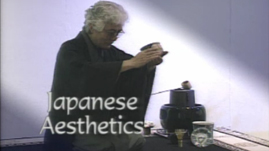Teachers' Domain - Digital Media for the Classroom and Professional Development
User: Preview



Shozo Sato provides a brief overview of Japanese aesthetics and explains the major differences between Western and Japanese aesthetics. He talks about the Japanese emphasis on stylization and the function of art and the artist in Japanese society. He also describes “maximum art” (such as Kabuki) and “minimal art” (such as haiku or rock garden) and the need for balance in both.
Find additional arts resources for your classroom at the KET Arts Toolkit website.
Aesthetics is the branch of philosophy that studies the arts and, especially, the principles of beauty. Japanese aesthetics are an integral part of the country’s culture and history. There are three sets of ancient ideals that are helpful to understanding Japanese aesthetics; wabi, sabi, and yugen. Wabi is transient and stark beauty. Sabi is the beauty of natural patina and aging. Yugen is profound grace and subtlety. Japan’s modern aesthetics encompass a variety of ideas and influences from other countries.
Unlike Western theater, which emphasizes realism and emotion, Japanese Kabuki theater is a triumph of stylization and skill. Aesthetic value is very important in Kabuki theater. Actors create characters not by expressing feelings, but through movement, dancing, and vocal expression. This emphasis on style, grace of movement, and vocal coloration adds to the aesthetic value of Kabuki theater.
The importance of aesthetics in Japanese culture is exemplified in the use of costumes, scenery, props, and stage devices used to enhance plot in Kabuki theater. Kabuki costumes are elaborate and ornamental. Actors typically change their costume for each new entrance. Kabuki theater is also known for its creative and symbolic use of props. Aesthetically, beautiful scenery and creative stage devices enhance Kabuki theater. One of the most important innovations in Kabuki theater was the use of the Hanamichi or “flower path.” It is a raised walkway that links the stage to the rear of the theater for the actors to make entrances and exits.
 Loading Standards
Loading Standards